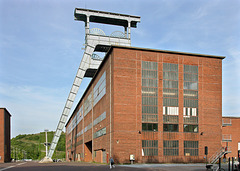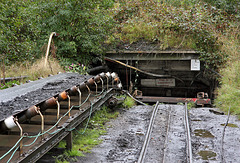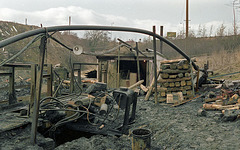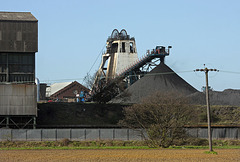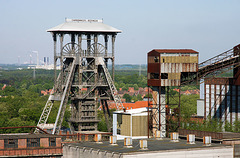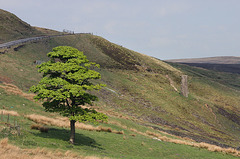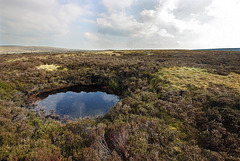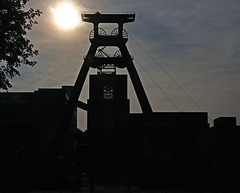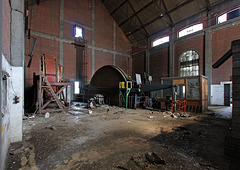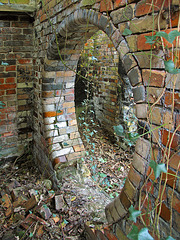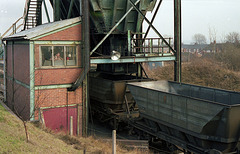
Coal Mining
Zeche Ewald
| |
|
Shaft 7 at the long established Ewald Colliery was sunk in the 1940s and the surface arrangements completed in 1949. This remained the main coal winding shaft until the colliery was closed in 2001.
Going underground
| |
|
Actually, I think it's coming out from underground. Production in full swing at Eckington Colliery.
High Carr No.4 Mine
| |
|
Winding house and tippler at High Carr No.4 Mine operated by the Great Row Colliery Co.Ltd. The road sign in the background is at the Junction of the A500 ('D Road') and the A34.
Zeche Amalie
| |
|
Although coal winding ceased at the combined Sälzer-Amalie colliery in 1966, some shafts, including that at Amalie have been retained for pumping and drainage purposes relating to other mines in the Ruhr. On the morning I took this photograph the wheels were spinning as winding operations were underway. An unusual feature is that the headframe steelwork is at an angle relative to the shaft tower.
Washery
| |
|
The headgear is just visible above the typical brick and concrete outline of the washery building at Breza Colliery.
Yorkshire coal
| |
|
The owners of Hatfield Colliery, Powerfuel Mining, were unable to raise the funds required to build the proposed clean coal power station on the site and the company was placed in administration at the end of 2010. In May 2011 with the formation of a new company, Hatfield Colliery Ltd, this has now been sold to Entero BV, a recently established Dutch holding company with funding from ING bank. This should secure the future of the colliery and the 400 people employed here.
Charbonnages de Beeringen
| |
|
The Beringen colliery was closed in 1989 and is now a museum with some parts open to visitors. Other bits are less accessible.
Zaojiatun
| |
|
The colliery system at Nanpiao was always worth visiting for the steam action on both branches with both passenger and coal trains. On a cold winter afternoon the passenger service is seen pulling away up the bank after a stop at the Zaojiatun Colliery.
Chimney and tree
| |
|
A lone tree and a lone chimney above the Dane Valley at Danebower. The collliery chimney served the boiler for a steam engine that drove an underground haulage system via a shaft. The chimney has recently seen extensive repair work to stabilise its condition.
Goyt's Moss Collieries
| |
|
The Buxton coalfield was extensively worked in the eighteenth century for the benefit of the Duke of Devonshire as landowner. The Goyt's Moss workings comprised a large number of shafts connected by raised roadways with the associated whim gins being moved from shaft to shaft as the workings progressed. Analysis of the accounts for 1790 suggests that usually three shafts were in operation at any one time, although two and four were also worked at times.
The image shows the remains of a collapsed eighteenth century shaft out on the moor. The lighter coloured patch on the right is part of the gin circle of which the remainder had been lost into the collapsed shaft which would have been 75 or 80 feet deep.
Schacht XII
| |
|
Zollverein colliery headstock over shaft No.12 is still used for drainage of the central Ruhr area although mining here ended in 1986. It forms an important landmark and is part of the Museum of the Ruhr and a World Heritage Site.
Zolder
| |
|
Zolder was the last colliery in the Benelux countries and closed in 1992. The machine hall still has much of the machinery remaining, including two Koepe winders.
Tower Pit
| |
|
The house with a view over the ice pond contains a significant piece of industrial archaeology.
The Poynton coalfield is divided by the Red Rock Fault, a major westerly downthrow which effectively precludes any mining on the western side due to the depth of the coal. In the first half of the nineteenth century the geological situation here was less well understood and Lord Vernon's agent Thomas Ashworth resolved to sink a pit on the west side to see whether workable seams could be found. A shaft was commenced in 1846 at the side of the colliery workshops in Towers Yard. It was discovered that the shaft was actually being sunk into the fault and conditions proved difficult. By 1848 it was concluded that they were wasting their time and the pit was abandoned, with Ashworth stating that "This rock is dangerous and objectionable" .
The slightly higher section of the modern house with a gable end towards the camera once housed the rotative beam engine used for the sinking of the shaft. For many years it was the cottage for the cowman at Towers Yard farm , but has recently been greatly extended and modernised.
Fan house
| |
|
|
Englefield Colliery near Greenfield was at work in 1869 and continued until c1937-38. The Coal Authority has recently destroyed the top of the upcast shaft with overenthusiastic safety measures to obliterate the shaft top, even though it was already filled-in almost to the surface. Fortunately there are still some interesting remains on site, including the fan drift from the upcast leading to the fan house and evasee.
This view is looking from the side of the fan house and the steam engine drive through the circular opening to the fan itself. There is an identical hole on the other side of the fan chamber which would have lead to an identical steam engine. The drive would have been taken from the cylinder/engine on one side, with the other as spare. It would not take long to change over if there was a breakdown. The brickwork includes many glazed examples and is all from various incarnations of the Rock Brick Company at Buckley.
Rapid loading
| |
|
There is plenty of supervision in the cabin during the loading the MGR hoppers under the bunker at Silverdale Colliery. The train was probably heading for Fiddler's Ferry power station when it departed behind Brush type 4 47 354.
Danethorn coal pits
| |
|
On a lovely spring afternoon I took a wander on the moors looking at the coal mining remains above Wildboarclough, to the south west of Danethorn Hollow. This stitch of six images is looking from the Buxton to Congleton road and Dane Valley on the left, to Shutlingsloe on the right.The land beyond the nearer wall is filled with mining remains as is the area immediately beyond the second walll. There are at least ten shafts and associated spoil heaps visible here. I think they are probably eighteenth century workings and judging by the remains they were not worked with a gin. These shallow pits were probably wound with a hand windlass.
Best viewed in original size .
Switch No.14
Blakelow Colliery 3
| |
|
Coal mining on the southern side of Macclesfield Common was concentrated around Blakelow via a number of shafts to the north-east of the current boundary of Macclesfield Golf Club. The Macclesfield Copper Company leased the Blakelow workings in the later eighteenth century and was extracting the coal from the two Holcombe Brook Seams using pillar and stall workings drained by a sough driven from lower down the hill towards Macclesfield town. The seams were thin and sometimes less than 2ft thick, but the quality was good enough to make it worthwhile extracting them.
The mound just above the frosted grass is the spoil heap and site of the third shaft at the colliery. There are sign of the loading bank in the sunken lane behind. The cart road back to the copper works is seen running steeply uphill at the right side and then turning left to pass Higher Blakelow Farm on its way to Lower Blakelow. It must have been hard work for the horses to surmount this bank, but once past Higher Blakelow it was all downhill. I am told that there is a fourth shaft, but this has now disappeared under the adjacent golf course.
Jump to top
RSS feed- Latest items - Subscribe to the latest items added to this album
- ipernity © 2007-2024
- Help & Contact
|
Club news
|
About ipernity
|
History |
ipernity Club & Prices |
Guide of good conduct
Donate | Group guidelines | Privacy policy | Terms of use | Statutes | In memoria -
Facebook
Twitter

